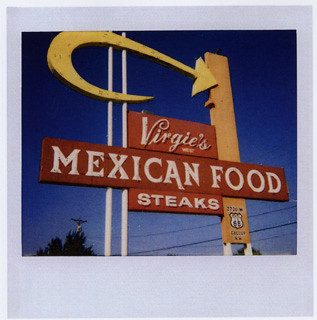
In an era where digital has become the dominant photography format, old-school cameras such as Holga, Diana and even Polaroid have made unexpected comebacks. These so-called lomographers like them because of their unpredictable images and often-vivid color.
So when photographer Christopher Robleski (see his work here) told me about his new book “Fading  Nostalgia: Polaroid Adventures on Route 66″ (80 pages, Blurb, $24.95 softcover, $35.95 hardcover), it struck me that it was apparently the first Route 66 volume featuring such “lo-fi” photography.
Nostalgia: Polaroid Adventures on Route 66″ (80 pages, Blurb, $24.95 softcover, $35.95 hardcover), it struck me that it was apparently the first Route 66 volume featuring such “lo-fi” photography.
In the forward, Robleski said he was inspired to drive and shoot images of Route 66 from seeing kitschy tourism brochures during road trips as a child.
This basic formula inspired me to travel along “the mother road” of U.S. Route 66, now as an adult, taking in the remaining roadside attractions from a simpler time. I wanted to capture the arresting decay and roadside thrills of the past, a highway littered with “Mom & Pop” businesses and other icons slowly being destroyed by time and corporations, a highway that once could take you from Chicago, Illinois, to Los Angeles, California.
My next choice was to capture what remains of the mother road to visualize for years to come. The means of which took only a manner of minutes to decide. The device was sitting in the back seat of my car: a couple of Polaroid cameras, and now everything was set in place for a road trip to remember for a lifetime.
The book’s subsequent pages are bare-bones, with little more than the actual-size Polaroid images and the town in which they were shot. Many of the photos are of old, weathered roadside signs.
But the Polaroid format does create some striking images.
The colors often become more saturated, such as the sign for Virgie’s Mexican Food in Gallup, N.M. (seen at top) and the Buckaroo Motel sign in Tucumcari, N.M.
Other images take on a retro quality. Shots of the Rest Haven Court sign in Springfield, Mo., and an abandoned gas pump and motel in Villa Ridge, Mo., look like something from the 1960s.
Still other images appear washed out; the blue sky looks pale or the signs appear faded. And the Polaroid format shows its unpredictable nature when a red splotch appears in the upper corner of an image of the Pony Soldier Motel sign in Tucumcari.
That’s the thing with older, more primitive cameras — you’re never quite sure what you’re going to get, and that’s part of the fun.
This made me wish the book was thicker. But Robleski told me the book already was becoming costly; he’s hoping he’ll eventually find a mainstream publisher to expand on the book’s format and text in a more cost-effective manner.
But “Fading Nostaglia” shows that lo-fi photography shows promise for the Mother Road. How about books of retro images of such aging Route 66 stalwarts as Angel Delgadillo or Bill Shea of Shea’s Petroliana Museum of Springfield, Ill.?